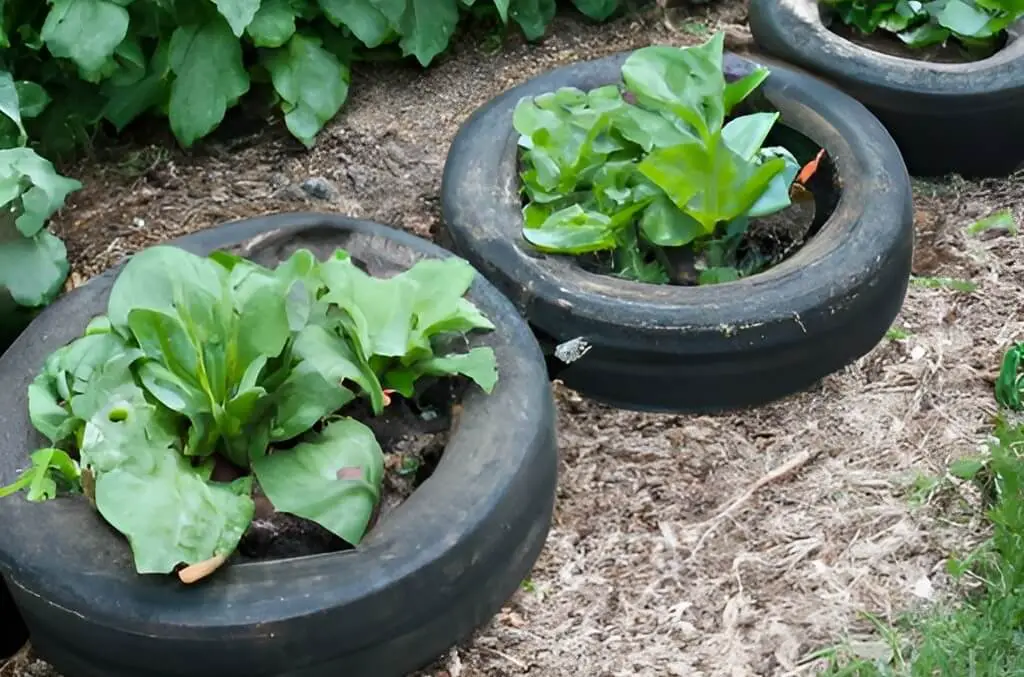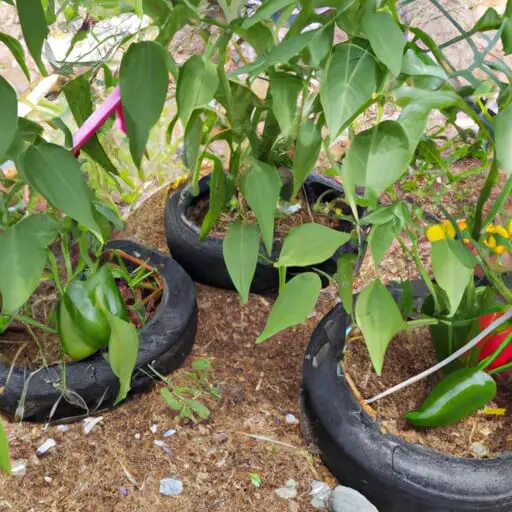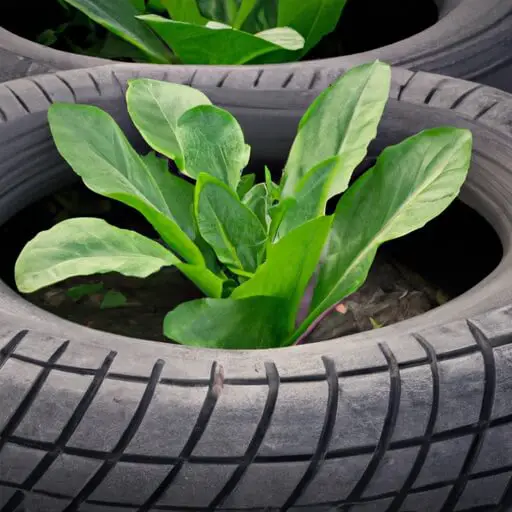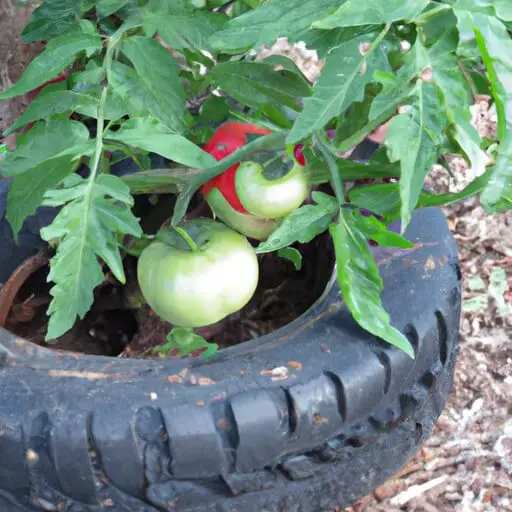As innovative gardeners experiment with tire vegetable garden ideas, a burning question emerges: “Is it safe to grow vegetables in old tires?” Tire gardening, though trendy, is layered with myths and truths. This guide promises clarity on the safety aspect, coupled with inspiration for your next project. So, shall we unearth the facts?
Repurposing old tires for gardening is a sustainable solution to the ever-present query: what to do with old tires. As enthusiasts dive into planting in tires, the appeal isn’t just in aesthetics but also in the seemingly innovative approach to gardening.
The rise of tire gardening brings forth both ornamental and functional uses. However, amidst the buzz, one must address the pivotal question: Is it safe to grow vegetables in old tires?

No, growing vegetables in old tires is not recommended. Tires contain harmful chemicals and heavy metals that can leach into the soil and get absorbed by plants. This poses potential health risks when consuming the harvested crops. For safe gardening practices, it’s advised to steer clear from planting vegetables in tires.
After encountering the snippet, it’s clearer that while planting vegetables in tires might be trendy, the primary concern revolves around safety. So, even if the question of can you grow vegetables in tires receives an affirmative answer, prioritizing health should come first.
In the world of gardening, sometimes tradition trumps trend. Before diving into tire gardening, one must weigh the pros and cons, focusing especially on long-term health implications.
The Appeal of Using Old Tires in Gardening
Old tires can be found in almost every garage, making them an accessible and seemingly convenient option for planting. Their prevalence has sparked a plethora of tire garden ideas, from practical planters to decorative displays.
Why Gardeners Opt for Tires:
With the increasing trend of planting in tires, many gardeners are exploring innovative techniques and designs. From tractor tire garden ideas to more simplistic styles, tire gardening has become a sought-after method for both practicality and aesthetic appeal.
- Cheap: Utilizing old tires as plant containers presents a cost-effective solution for gardening enthusiasts. This affordability has catalyzed numerous DIY tire garden ideas, transforming tires into creative and functional planters. Instead of splurging on ornamental pots, gardeners can now save by repurposing what they already have.
- Easily Available: Tires are everywhere. From compact car wheels to tractor tire garden ideas, they’re a staple in many households. Their abundance ensures that gardeners don’t have to hunt for supplies when the inspiration for decoration tire garden ideas strikes.
- Durable: Built to withstand challenging road conditions and inclement weather, tires’ durability in the garden is unquestioned. This resilience, however, does prompt valid concerns. As discussions about is it safe to grow vegetables in old tires intensify, gardeners also delve into the risks of growing vegetables in old tires. The challenge lies not just in using them, but understanding how to safely use tires for vegetable gardens to ensure both plant health and personal well-being.
Must check: Why Do People Put Tires on Their Roofs? Discovering the Reasons
Benefits of Using Tires for Gardening
Old tires, when used right, can indeed offer certain advantages for garden enthusiasts. The numerous benefits of growing vegetables in tires extend beyond the obvious economic savings.
Heat Retention and Early Planting
Tires are excellent at absorbing and retaining heat, providing a microclimate for plants. This heat retention allows for earlier planting in the season, making it one of the significant tire garden benefits.

While the benefits of growing vegetables in old tires include faster seed germination and growth, gardeners should always assess: is it safe to grow vegetables in old tires?
Portability and Ease of Setup
Tires are easy to move and set up, making them a flexible option for gardeners who might want to rearrange their gardens periodically. Their inherent portability ensures that sustainable tire gardening can be practiced in various spaces, from patios to backyards.
Re-purposing and Waste Reduction
By reusing old tires, gardeners contribute to reducing waste, embodying the environmental benefits of reusing tires for gardening. Such an approach not only declutters the environment but also provides a sustainable and eco-friendly alternative to discarding them.
Low Maintenance and Cost-effective
One of the underrated benefits of growing vegetables in old tires is their low maintenance nature. Tires are robust and durable, meaning they don’t crack like traditional pots.
Plus, using them in the garden is a cost-effective method, eliminating the need for frequent replacements or repairs, further promoting sustainable tire gardening.
Potential Concerns of Using Tires for Planting
While tires have many benefits as a planting vessel, they’re not without potential hazards. Many gardeners ponder, can I plant vegetables in old tires without jeopardizing my health?
Chemical Leaching
A significant concern is whether do tires leach chemicals into the soil. Indeed, tires contain a myriad of chemicals, and over time, there’s a possibility these might leach into the soil, affecting plant health.
The chemicals in old tires affecting plants can alter growth patterns and reduce crop yield, making it essential to question: are tires toxic for gardening?
Heat Absorption and Soil Temperature
Another downside of planting vegetables in old tires is the material’s heat absorption properties. While this can benefit early planting, excessive heat can also harm delicate root systems and increase soil evaporation rates. Gardeners must be wary of how this impacts plants during peak summer months.
Water Drainage and Root Health
Ensuring good water drainage is crucial for any plant’s health. Tires, if not modified correctly, can retain excess water, leading to root rot and other complications. Achieving the right balance in moisture levels becomes pivotal when using tires as plant containers.
Limited Soil Depth
One of the overlooked risks of using old tires for gardening is the shallow soil depth they offer. For plants with deep-root systems or those requiring ample space to flourish, this limitation can stunt growth and even lead to overcrowded conditions.
Chemical Off-gassing
Tires can release gaseous chemicals, especially when exposed to intense sunlight. This off-gassing poses a potential risk, especially when considering the risks of growing vegetables in old tires. Airborne toxins can potentially settle on plant surfaces or be absorbed, adding another layer of concern to the debate.
Must check: Where Can I Dispose of Tires for Free? Best Strategies & Locations
Is It Safe to Grow Vegetables in Old Tires?
Utilizing old tires in innovative ways, like decoration tire garden ideas, is popular. However, when it comes to planting vegetables in old tires, there are concerns. Tires can contain chemicals harmful to humans, like benzene and polycyclic aromatic hydrocarbons (PAHs). Research indicates these chemicals can leach into the soil, raising questions about tire gardening safety, especially when focusing on tire vegetable garden ideas.
Growing vegetables in old tires can be risky due to potential chemical leaching. While some believe the short growing season limits exposure, there are unanswered questions about the potential health risks of tire gardens. It’s safer to explore other gardening alternatives.
Asking, “can you grow vegetables in tires?” isn’t just about plant health but also human health. Some of the adverse health effects from tire chemical exposure include respiratory issues and cancer risk. If considering planting in tires, you should weigh the pros and cons.

As a proactive measure, you might ask, “what to do with old tires” that doesn’t involve food. This way, you can avoid the question, “do tires leach chemicals into the soil” altogether. Overall, if you’re pondering, “is it unhealthy to grow vegetables in old tires” or “is it safe to grow food in tires”, it’s advised to opt for safer alternatives.
What Research Says:
The surge in DIY tire garden ideas has prompted significant research to address gardeners’ primary concerns. Amidst the plethora of garden ideas with tires, a crucial question looms: are tires toxic for gardening? This research summary delves into the findings to provide clarity.
Chemicals in Soil
Many studies focus on whether tires can release harmful chemicals into the soil. Tires, by their very nature, are a cocktail of compounds and elements. This leads many to wonder, is it safe to grow food in tires? Research indicates that as tires degrade, there’s potential for leaching, which can adversely impact the soil health.
Effect on Plant Health and Growth
When contemplating vegetable gardening in old tires, it’s essential to consider the plants’ health. Some findings suggest that compounds from tires can stunt plant growth. The pressing concern remains, are old tires toxic for plants? While some plants may exhibit resilience, others can be significantly affected.
Safety of Consuming Produce
Considering the potential health risks of tire gardens, it’s crucial to address the safety of consuming such produce. Early research points towards the possibility of plants absorbing harmful chemicals. Hence, while is growing vegetables in tires safe is a debatable topic, it’s paramount to know how to safely use tires for vegetable gardens to mitigate risks.
Must check: How Long Can You Drive on Tires with Wire Showing? The Risk Revealed
Safe Practices for Tire Gardening
If you’re considering giving tire gardening a try, here are some practices to ensure the safety and health of your plants and yourself. Embracing these precautions for tire gardening ensures a fulfilling gardening experience.
Choosing the Right Tires
It’s essential to understand how to choose the right tires for a tire garden. Not all tires are made equally, and some might contain higher amounts of toxic materials than others. Begin by selecting tires that show minimal wear and tear, indicating reduced leaching potential.

Additionally, avoid tires that have been treated with chemical sealants or those with visible mold or fungal growth. One of the top tire garden safety tips is to opt for newer tires, as they often have fewer harmful chemicals than their older counterparts.
Proper Preparation and Cleaning
Once you’ve made your tire selection, the next step involves understanding how to prepare tires for gardening. Before any planting, you must clean and prep old tires for planting to remove any residues, pollutants, or potentially harmful substances.
Using a mixture of water, mild soap, and a scrub brush, thoroughly clean the inside and outside of each tire. Rinsing several times ensures that all cleaning agents are removed.
After cleaning, consider making drainage holes at the bottom. This not only helps with water management but also minimizes any potential for stagnant water to breed pests.
Properly preparing tires for a tire garden goes beyond cleaning; it also involves placing them in an appropriate location where they receive adequate sunlight and are not in direct contact with contaminants.
Monitoring Soil Health and Quality
One of the most critical aspects of tire gardening is ensuring that your soil is safe and nutrient-rich. When pondering how to check tire safety for gardening, it’s wise to invest in a soil test kit. This kit allows you to monitor pH levels, nutrient content, and any potential contaminants.
It’s vital to use the best soil mix for tire gardens – a blend of compost, potting soil, and perlite is often recommended. Such a mix provides good drainage, necessary nutrients, and minimizes the potential for harmful leachates to affect plant roots.
For those seeking a visual perspective on planting vegetables in old tires, we’ve sourced an insightful video from Simplify Gardening. This video delves into innovative ways to repurpose old tires in the garden while discussing the pros and cons. If you’re contemplating alternatives to using old tires for gardening, this is a must-watch to guide your decision-making.
In conclusion, while tire gardening presents an innovative and sustainable approach to growing plants, it’s paramount to be equipped with the right knowledge. By meticulously choosing, preparing, and maintaining your tire garden, you ensure a safe environment for both the plants and those consuming their produce.
Must check: How Long Do Tires Last If Not Used? The Ultimate Guide
Best Vegetables to Grow in Tires
Tire gardens have emerged as a favorite among gardeners looking for innovative, cost-effective solutions. When diving into vegetable gardening in old tires, choosing the right vegetables is paramount to ensure both growth and safety. While growing tomatoes in tires has become a trendy choice, there are several other options available.
Robust Vegetables Ideal for Tire Gardens: Tomatoes, Potatoes, and Squash.
Starting with tomatoes, they’re one of the best vegetables to grow in tires. Their deep roots, coupled with the warmth provided by the tire, facilitate optimal growth.
Next, potatoes are a robust choice for tire gardens. Contrary to popular belief, when done correctly, it is safe to grow potatoes in tires, as long as there are precautions in place.
Squash, with its sprawling nature, can also find a cozy home in tires. This trio represents a blend of veggies that not only thrive in tire conditions but also exhibit resilience.
The Ability of Certain Plants to Absorb or Resist Toxins.
While pondering the question, “What can you plant in old tires?”, it’s essential to understand that not all plants react similarly to potential toxins. Some vegetables, due to their nature or root structure, can absorb more chemicals, whereas others might resist them.
For example, root vegetables like carrots or radishes might be more susceptible to absorbing substances from the soil than above-ground vegetables. Knowledge of these specifics is one of the key tire gardening tricks every enthusiast should arm themselves with.
Specific Guidelines for Growing Tomatoes, Pumpkins, and Potatoes in Tires.
When planting vegetables in tires, especially crops like tomatoes, pumpkins, and potatoes, specific guidelines must be followed to ensure healthy growth and safety.
- Tomatoes: For those interested in growing tomatoes in tires, ensure you use well-draining soil and maintain consistent moisture levels. Tomatoes prefer a warm environment, making tires an ideal fit. However, always ensure there’s enough depth for roots to expand. Use stakes or cages for support as they grow.

- Pumpkins: Pumpkins require ample space. Thus, larger tires, such as tractor tire garden ideas, can be ideal. Ensure you have enriched soil and provide plenty of sunlight. Monitor for pests and water regularly.
- Potatoes: One of the best vegetables to grow in tire gardens, potatoes require a layering method. Start by planting them at the base of the tire. As they grow, add another tire and fill it with soil, allowing the plant to expand upward. This method ensures a more significant yield. Regular watering, without waterlogging, is key.
Conclusively, while the allure of vegetable gardening in old tires is undeniable, knowledge and precautions can lead to bountiful, safe harvests. This innovative method, when done right, can be both rewarding and sustainable.
Must check: Can You Mix Air and Nitrogen in Tires for Safety and Efficiency?
Safer Alternatives to Tires for Gardening
If you’re reconsidering tires, there are many safe and sustainable alternatives for your garden. Not only can these choices offer a safer environment for plant growth, but they can also enhance the aesthetic appeal of your garden space. Opting for alternatives to using old tires for gardening doesn’t mean compromising on innovation or sustainability.
Raised Wooden Beds
A classic and eco-friendly choice, raised wooden beds provide an ideal environment for plant growth. They allow for better control over soil quality, and the wood acts as a natural insulator, moderating soil temperature.
Unlike tires, wood doesn’t pose the risk of chemical leaching, making it a preferred alternative to tire gardens for many organic gardeners.
Additionally, wooden beds can be customized to fit various garden sizes and designs, offering flexibility in their application.
Ceramic Pots
Ceramic pots stand as a timeless tire garden alternative that combines aesthetics with functionality. Their porous nature facilitates good air and water movement, ensuring the roots remain healthy.
Besides, ceramics don’t leach harmful chemicals into the soil, ensuring that your plants remain uncontaminated. Available in various sizes, designs, and colors, ceramic pots can be chosen to complement the overall theme of your garden.
Recycled Containers
As we delve deeper into sustainable and cost-effective alternatives for your garden, recycled containers make a notable mention. Old buckets, barrels, and even discarded household containers can be repurposed into unique plant holders.
By drilling drainage holes at the bottom and adding a layer of stones or gravel, these containers can support a variety of plants. This method not only aligns with the concept of recycling but also showcases innovative ways to repurpose old items in the garden without resorting to tires.
In conclusion, while tire gardening has its appeal, it’s reassuring to know there are many tire garden alternatives available. By opting for safer materials, gardeners can create a healthy and harmonious environment for their plants, ensuring both growth and safety.
Do you know? How Long Can You Drive on a Broken Tire Belt Safely?
FAQs: Unearthing the Truth About Tire Gardening Safety
The increasing trend of planting vegetables in tires has led to a myriad of questions. Among them, many wonder: can you grow vegetables in tires? And what about the concerns that tires leach chemicals into the soil? Dive into these FAQs to find answers.
-
Is it safe to plant vegetables in tires?
The question of whether it’s safe to plant vegetables in old tires remains one of great debate. Using tires in the garden, especially for tire vegetable garden ideas, has become popular due to their availability and durability. However, there are concerns regarding the possibility that tires leach chemicals into the soil. Some studies suggest that tires can release zinc, heavy metals, and other chemicals, which could be taken up by plants, potentially making it unsafe for gardening. Thus, while it’s possible to use them, it’s essential to understand the associated risks and take preventive measures to ensure plant and human safety.
-
Is it safe to grow potatoes in tires?
Growing potatoes in tires is one of the more popular tire vegetable garden ideas. The pros and cons of growing potatoes in tires need to be weighed before proceeding. On the plus side, tires provide warmth, which can help potatoes sprout and grow faster. On the downside, the concerns about chemical leaching come into play. It’s essential to ensure that the tires haven’t been treated with harmful chemicals and to occasionally test the soil for potential contaminants.
-
Is it safe to grow vegetables in plastic containers?
Growing vegetables in plastic containers is generally safe, provided you use food-grade plastic. Avoid plastics labeled with recycle codes 3 (polyvinyl chloride) and 7 (other), as these may contain harmful chemicals. Ensure the containers offer good drainage and are large enough to accommodate the plants’ growth. Remember, some plastics can degrade over time, especially under prolonged sun exposure, so it’s crucial to check their condition periodically.
-
How to safely use tires for vegetable gardens?
If you’re adamant about using tires in the garden for vegetables, take some precautions. Firstly, it’s advisable to use tires that are in good condition. Avoid tires that show signs of degradation, as these might have a higher likelihood of leaching. Opt for growing vegetables in old tires that don’t have prolonged exposure to direct sunlight to reduce heat absorption, which can intensify chemical release. Additionally, using a liner inside the tire, such as landscape fabric, can act as a barrier between the tire and the soil. Regularly testing the soil for contaminants ensures you’re keeping track of its health.
-
Are old tires toxic for plants?
Old tires, especially those degraded by sun and weather, have the potential to release harmful compounds. Chemicals such as zinc, benzothiazole, and even heavy metals have been found in minute amounts in soils adjacent to tires. While some plants can tolerate or even thrive in these conditions, there’s a potential risk of these contaminants being absorbed by the plants, which can pose risks if the produce is consumed. So, while not inherently toxic, tires can pose risks for gardening under certain conditions.
-
How to prevent chemical leaching in tire gardens?
Preventing chemical leaching is crucial if you’re committed to growing vegetables in old tires. Here are some steps you can follow:
1. Choose the Right Tires: Some newer tires might have fewer harmful chemicals than older ones. Doing some research into the tire’s make and materials can be beneficial.
2. Use Liners: Using liners, like landscape fabric or even plastic sheeting, can create a barrier between the soil and the tire, reducing the risk of leaching.
3. Position Away from Direct Sunlight: Prolonged exposure to sunlight can increase the rate of leaching. Place your tire planters in a location where they receive sunlight but are shielded during the hottest parts of the day.
4. Monitor Soil Health: Regularly test the soil for contaminants. If you notice elevated levels of any harmful compounds, consider changing the soil and reassessing the use of tires for your plants.
In summary, while tires offer innovative gardening solutions, their potential risks can’t be ignored. By being informed and taking preventive measures, gardeners can find a balance that works for their specific needs.
Assessing the Safety of Growing Vegetables in Old Tires
When it comes to gardening in tires, many environmental enthusiasts see it as a creative and sustainable way to repurpose old tires. These gardens not only offer heat retention but also portability, making tire vegetable garden ideas quite popular. Yet, beneath the soil, there’s more to consider.
Old tires contain various chemicals and metals potentially harmful to humans. Even though no studies have directly analyzed toxin levels in veggies grown in such settings, the risk of chemical leaching is evident. Given the potential dangers and the abundance of safer alternatives, it’s generally advised against using tires for edible gardens.
While the concept of organic tire gardening may sound eco-friendly, the real concern lies in the chemicals like Benzothiazoles and PAHs which could compromise vegetable safety. Thus, the question remains: is it safe to grow vegetables in old tires? As we integrate planting in tires into modern gardening, it’s imperative to prioritize health.
For those contemplating using tires in the garden, caution is key. Until thorough research validates the safety of growing vegetables in old tires, it might be wise to stick to traditional gardening or explore safer repurposing ideas for old tires.
Don’t miss out on these related topics: